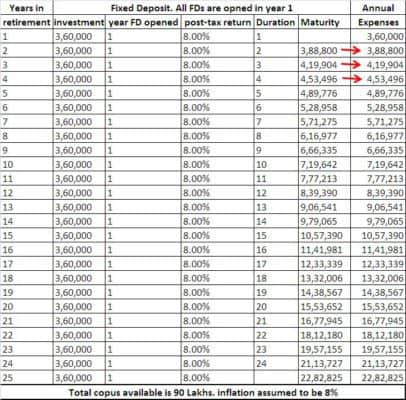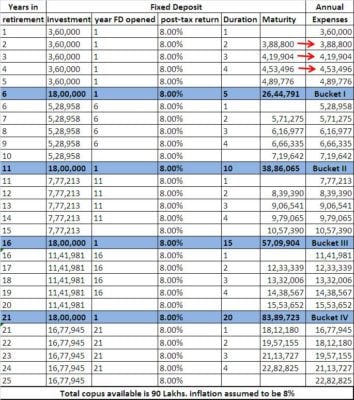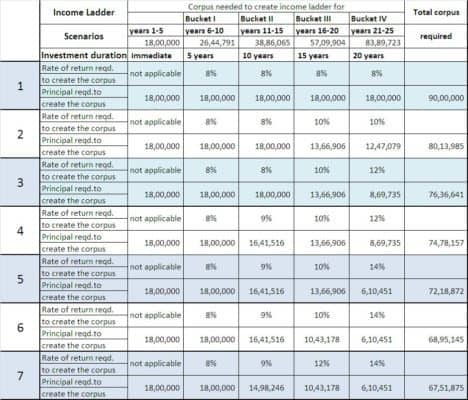Last Updated on September 4, 2018 at 10:57 am
Given a lump sum, how do we invest it in order to create a reliable income stream that is risk-free and has the ability to keep pace with inflation?
This is the most crucial question that concerns every person who is retired, nearing retirement, or planning for someone else’s retirement (a client or a parent perhaps). Well, at least it ought to be!
The answer concerns everyone since we all have to answer this question at some point in our life.
This post is an offshoot of a discussion with Vignesh Bhaskar in Asan Ideas for Wealth, FB group. Not much information is available on inflation proof post-retirement investment strategies for the Indian scenario. Let us try and discuss this here from time to time.
Join 32,000+ readers and get free money management solutions delivered to your inbox! Subscribe to get posts via email! (Link takes you to our email sign-up form)
🔥Want to create a complete financial plan? Learn goal-based investing? Exclusive access to our DIY tools? Increase your income with your skills? Use this link to enjoy massive discounts on our robo-advisory tool & courses! 🔥
Most questions have more than one solution. This is no different. There are many ways of creating a reliable inflation-protected income stream. In this post, I will discuss only one such way.
The best way to do this is via an illustration.
Let us say that I am a retiree, aged 60, with Rs. 30,000 monthly expenses (involving only the retiree and dependents) or Rs. 3,60,000 per year. Perhaps a touch on the lower side.
I make the following assumptions
- Inflation throughout the retiree lifetime: 8%
- Inflation-protected income required for: 25 years That is up to 85 years. Perhaps 30 years would have been better, but let us work with 25.
- Mediclaim: Available. Premium expenses included in the annual expenses.
- Emergency fund: Available. A sum equal to 1 year’s expenses. This is not part of the retirement corpus.
Now we will need to calculate the corpus required
I have assumed that I pay a flat 10% tax on all investments throughout my lifetime. This is indeed an oversimplification. Unfortunately, we will need to use this, as it will be confusing to consider other possibilities.
A post-tax return of 8% may seem a bit unrealistic. However, if a retiree in the 10% tax slab opts for fixed deposits offering 9% for senior citizens (current rates), the post-tax return is about 8%.
Using the annuity calculator, we determine the corpus required
Inputs
Payout required in the first year of retirement: Rs. 3, 60,000
Inflation: 8%
Post-tax return: 8%
Duration: 25 years
Output
Corpus required: Rs. 90,00000 or Rs. 90 Lakhs
If I have an amount close to this or higher than this, I can relax.
What if I have a corpus less than 90 Lakhs? What should I do?
In order to answer this and the question posed in the opening sentence, let us first try to understand why I need Rs. 90 Lakhs given the other inputs.
If I divide this 90 Lakhs into 25 parts, each part is equal to 3.6 Lakhs. This is just the amount I need for meeting my expenses in the first year of retirement.
- I keep aside one part for meeting the first years expenses.
- I then open 24 fixed deposits. Each maturing one year after the other. That is the first FD will mature after one year, the second FD after two years … the last FD after 24 years.
- When the 1st FD (investment = 3.6 L) matures, I will get 3.88L enough to meet expenses in the 2nd year of retirement (here expenses have been inflated by 8%)
- When the 2nd FD (investment = 3.6 L) matures, I will get 4.19L enough to meet expenses in the 3rd year of retirement (here expenses have been inflated by 8%)
- …..
- …..
- When the 24th FD (investment = 3.6 L) matures, I will get 22.8 L enough to meet expenses in the 25th year of retirement (here expenses have been inflated by 8%)
Here is an illustration which explains why I need 90L
Suppose I do not have 90 L. Can I work with a lower corpus and yet mange to generate inflation protected income?
To a certain extent, it is possible. Of course, as must be obvious, one will need to generate a higher rate of return. This implies taking on some risk … with a part of the corpus.
In order to understand this, we will need to discuss about the so-called bucket strategy
The best way to do that is to use the above numbers.
Instead of opening 24 FDs, I can achieve the same result in a different.
- I keep away 3.6L for the 1st year.
- I open 4 FD for 3.6L maturing one year after another as mentioned above.
- This will give me inflation-protected income for the first 5 years in retirement.
- This is called income laddering (also one form of FD laddering)
I invest 18L in an FD that matures in 5 years. Let us call this bucket I
I invest 18L in an FD that matures in 10 years. Let us call this bucket II
I invest 18L in an FD that matures in 15 years. Let us call this bucket III
I invest 18L in an FD that matures in 20 years. Let us call this bucket IV
- Bucket I will mature to 26.44 L. I then split this up into 5 parts, keep one for managing expenses in the 6th year of retirement and use the remaining parts for managing expenses in years 7 to 10 by income laddering.
- Similarly, bucket II will mature to 38.86 L. I then split this up into 5 parts, keep one for managing expenses in the 11th year of retirement and use the remaining parts for managing expenses in years 12 to 15 by income laddering.
- … and so on.
Here is an illustration
In essence, instead of creating an income ladder for 25 years, as mentioned infirst scenario, we create an income ladder for the first 5 years, let the rest of the corpus compound in four buckets, and create new income ladder every five years.
I have assumed that all the buckets compound with the rate of return (8%). So there is no difference between the first and second scenarios. In effect the total corpus needed is the same.
What if, some of the buckets compounded with a higher rate of return?
Can I then not reduce the total corpus required?
Yes, this is indeed possible. Here is a list of different return scenarios. Thanks to Captain Ashok Kumar Anand for pointing out an error in this table. It has now been corrected.
Notice that the returns associated with different buckets have been varied. The first scenario, of course corresponds to the one detailed above.
Notice that as you increase the return in different buckets, preferably the ones which you will need 10, 15 and 20 years later, the corpus required comes down quite sharply from 90 L to 67.5 L
How can I go about achieving this?
Here are some examples
Low risk
Bucket 1 (5Y duration): FDs
Bucket 2 (10Y): Debt ‘income’ funds
Bucket 3 (15Y): Balanced funds (25% equity)
Bucket 4 (20Y): Balanced funds (65% equity)
Medium risk
Bucket 1 (5Y duration): FDs
Bucket 2 (10Y): FDs
Bucket 3 (15Y): Balanced funds (65% equity)
Bucket 4 (20Y): Diversified equity
High risk
Bucket 1 (5Y duration): FDs
Bucket 2 (10Y): Debt ‘income’ funds
Bucket 3 (15Y): Diversified equity
Bucket 4 (20Y): Diversified equity
How to decide what to do?
This is a tough question!
- If I have 90L+ I can afford to choose the no-risk option (all buckets in FDs)
- If I have ~ 80L I will need to take some risk and invest buckets 3 and 4 in high return, tax-efficient instruments
- If I have ~ 70-75L I will need to take much more risk and invest buckets 2, 3 and 4 in high return, tax-efficient instruments. Do I have the stomach for this? If I don’t, I will have to choose a constant annuity from an insurer and my income will have little or no inflation-protection
- If have less than 70L, it is too risky to use buckets. I will have to resign myself to the fate of receiving constant annuity
- Note: This is a ‘all-in’ strategy. That is once you choose the bucket approach, seeking annuity later in life may not (or may!) give you a decent pension. So you will to consider your health into the equation (thanks to Subra for pointing this out). Are you fit enough to manage your own corpus?
What would you do?
Are you doing enough to ensure that you don’t face the prospects of constant annuity?
I apologise for the heavy content of this post. If you have made it this far, thank you! If you need clarifications on any aspect of the post, please feel free to ask.
I have an associated calculator. If you are interested in it, let me know, and I will post the download link.
Download the Inflation-protected Income Simulator

Use our Robo-advisory Tool to create a complete financial plan! ⇐More than 3,000 investors and advisors use this! Use the discount code: robo25 for a 20% discount. Plan your retirement (early, normal, before, and after), as well as non-recurring financial goals (such as child education) and recurring financial goals (like holidays and appliance purchases). The tool would help anyone aged 18 to 80 plan for their retirement, as well as six other non-recurring financial goals and four recurring financial goals, with a detailed cash flow summary.
🔥You can also avail massive discounts on our courses and the freefincal investor circle! 🔥& join our community of 8000+ users!
Track your mutual funds and stock investments with this Google Sheet!
We also publish monthly equity mutual funds, debt and hybrid mutual funds, index funds, and ETF screeners, as well as momentum and low-volatility stock screeners.
You can follow our articles on Google News

We have over 1,000 videos on YouTube!

Join our WhatsApp Channel



- Do you have a comment about the above article? Reach out to us on Twitter: @freefincal or @pattufreefincal
- Have a question? Subscribe to our newsletter using the form below.
- Hit 'reply' to any email from us! We do not offer personalised investment advice. We can write a detailed article without mentioning your name if you have a generic question.
Join 32,000+ readers and get free money management solutions delivered to your inbox! Subscribe to get posts via email! (Link takes you to our email sign-up form)
About The Author
 Dr M. Pattabiraman (PhD) is the founder, managing editor and primary author of freefincal. He is an associate professor at the Indian Institute of Technology, Madras. He has over 13 years of experience publishing news analysis, research and financial product development. Connect with him via Twitter(X), LinkedIn, or YouTube. Pattabiraman has co-authored three print books: (1) You can be rich too with goal-based investing (CNBC TV18) for DIY investors. (2) Gamechanger for young earners. (3) Chinchu Gets a Superpower! for kids. He has also written seven other free e-books on various money management topics. He is a patron and co-founder of “Fee-only India,” an organisation promoting unbiased, commission-free, AUM-independent investment advice.
Dr M. Pattabiraman (PhD) is the founder, managing editor and primary author of freefincal. He is an associate professor at the Indian Institute of Technology, Madras. He has over 13 years of experience publishing news analysis, research and financial product development. Connect with him via Twitter(X), LinkedIn, or YouTube. Pattabiraman has co-authored three print books: (1) You can be rich too with goal-based investing (CNBC TV18) for DIY investors. (2) Gamechanger for young earners. (3) Chinchu Gets a Superpower! for kids. He has also written seven other free e-books on various money management topics. He is a patron and co-founder of “Fee-only India,” an organisation promoting unbiased, commission-free, AUM-independent investment advice.Our flagship course! Learn to manage your portfolio like a pro to achieve your goals regardless of market conditions! ⇐ More than 3,500 investors and advisors are part of our exclusive community! Get clarity on how to plan for your goals and achieve the necessary corpus no matter the market condition!! Watch the first lecture for free! One-time payment! No recurring fees! Life-long access to videos! Reduce fear, uncertainty and doubt while investing! Learn how to plan for your goals before and after retirement with confidence.
Increase your income by getting people to pay for your skills! ⇐ More than 800 salaried employees, entrepreneurs and financial advisors are part of our exclusive community! Learn how to get people to pay for your skills! Whether you are a professional or small business owner seeking more clients through online visibility, or a salaried individual looking for a side income or passive income, we will show you how to achieve this by showcasing your skills and building a community that trusts and pays you. (watch 1st lecture for free). One-time payment! No recurring fees! Life-long access to videos!
Our book for kids: “Chinchu Gets a Superpower!” is now available!


Must-read book even for adults! This is something that every parent should teach their kids right from their young age. The importance of money management and decision making based on their wants and needs. Very nicely written in simple terms. - Arun.Buy the book: Chinchu gets a superpower for your child!
How to profit from content writing: Our new ebook is for those interested in getting a side income via content writing. It is available at a 50% discount for Rs. 500 only!
Do you want to check if the market is overvalued or undervalued? Use our market valuation tool (it will work with any index!), or get the Tactical Buy/Sell timing tool!
We publish monthly mutual fund screeners and momentum, low-volatility stock screeners.
About freefincal & its content policy. Freefincal is a News Media organisation dedicated to providing original analysis, reports, reviews and insights on mutual funds, stocks, investing, retirement and personal finance developments. We do so without conflict of interest and bias. Follow us on Google News. Freefincal serves more than three million readers a year (5 million page views) with articles based only on factual information and detailed analysis by its authors. All statements made will be verified with credible and knowledgeable sources before publication. Freefincal does not publish paid articles, promotions, PR, satire or opinions without data. All opinions will be inferences backed by verifiable, reproducible evidence/data. Contact Information: To get in touch, please use our contact form. (Sponsored posts or paid collaborations will not be entertained.)
Connect with us on social media
- Twitter @freefincal
- Subscribe to our YouTube Videos
- Posts feed via Feedburner.
Our publications
You Can Be Rich Too with Goal-Based Investing
 Published by CNBC TV18, this book is designed to help you ask the right questions and find the correct answers. Additionally, it comes with nine online calculators, allowing you to create custom solutions tailored to your lifestyle. Get it now.
Published by CNBC TV18, this book is designed to help you ask the right questions and find the correct answers. Additionally, it comes with nine online calculators, allowing you to create custom solutions tailored to your lifestyle. Get it now.Gamechanger: Forget Startups, Join Corporate & Still Live the Rich Life You Want
 This book is designed for young earners to get their basics right from the start! It will also help you travel to exotic places at a low cost! Get it or gift it to a young earner.
This book is designed for young earners to get their basics right from the start! It will also help you travel to exotic places at a low cost! Get it or gift it to a young earner.Your Ultimate Guide to Travel
 This is an in-depth exploration of vacation planning, including finding affordable flights, budget accommodations, and practical travel tips. It also examines the benefits of travelling slowly, both financially and psychologically, with links to relevant web pages and guidance at every step. Get the PDF for Rs 300 (instant download)
This is an in-depth exploration of vacation planning, including finding affordable flights, budget accommodations, and practical travel tips. It also examines the benefits of travelling slowly, both financially and psychologically, with links to relevant web pages and guidance at every step. Get the PDF for Rs 300 (instant download)

